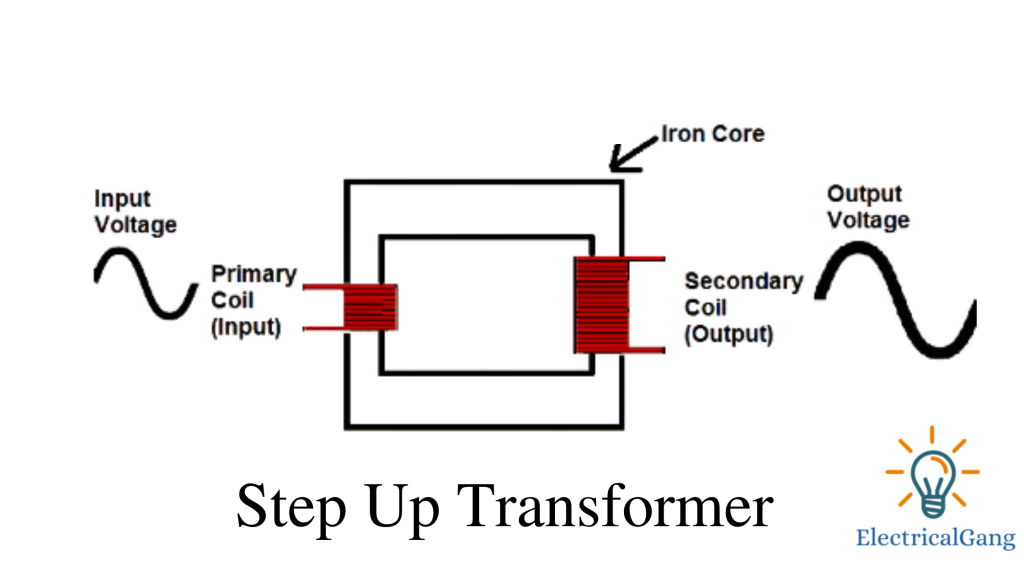Hello friends, in today’s article, we will see what is the definition of the difference between step up and step down transformer.
A transformer is a stationary device that does not have rotating parts like any motor. Thus power is sent from one circuit to another at the same frequency but only on the secondary side you. If there is a step-up transformer, you will get more voltage, and if there is a step-down, you will get less voltage.
The main difference between a step-up and a step-down transformer is that one increases the voltage while the other decreases the voltage. The secondary voltage in the step sub-transformer is higher than the primary, while the secondary voltage is lower than the primary in the step-down. There is no significant difference in the construction of this iron; it is only important from an operational point of view. Let us first see what the definition of Bane is.
Definition of Step-up Transformer:
The step-up transformer has a higher voltage on the secondary side. Hence it is called a step-up transformer. In this, in the secondary winding, the number of turns is kept more in the secondary winding than in the primary winding, due to which its output is higher than the primary winding.

In countries like India, power generation is mostly done at 11Kv. In India, for economic reasons, electricity is sent over long distances, which is why such transformers are used to deliver electricity at 220Kv or 440Kv with the help of high towers. In such a time, its place in any power plant becomes important.
Definition of Step Down Transformer:
The secondary winding has fewer turns than the primary winding in a step-down transformer. Because of this, you get less voltage in the output than on the perimeter side. In a way, high power and high voltage convert low power to low voltage.

At the end of delivering electricity in small areas, transformers are used such as 220Kv or 400Kv so high the power we can not use any space just because we are below 220Kv/230V, i.e., step down. It has fewer turns in secondary than primary, so less output is obtained.
Difference Between Step-up And Step-Down Transformer:
| Basic | Step-up Transformer | Step Down Transformer |
| Definition | in a step-up transformer, the secondary voltage is increased | Step-down transformer lowers secondary voltage. |
| Voltage | The input voltage is low, while the output voltage is high | The input voltage is higher, while the output voltage is lower |
| Winding | The high-voltage winding is on the secondary side. | The high-voltage winding is the primary side |
| Current | The current is higher on the secondary side than on the primary side | The current is less on the secondary side than on the primary side |
| Size of the conductor | The primary winding is made of thick insulated copper wire. | The secondary winding is made of thick insulated copper wire. |
| Rating of output voltage | 11000 volts or above | 110v ,24v, 20v, 10v, etc. |
| Application | The power plant, X-rays machine, microwaves, etc. | Doorbell, voltage converter, distribution. The transformer in residential colony etc. |
Significant Differences Between a step-up transformer and a step-down transformer:
When the voltage on the secondary side is higher than the primary, such a transformer is called a step-up transformer. Thus if the voltage on the secondary side is less, then it is called a step-down transformer.
In a step-up transformer, the low voltage is on the primary side, while the higher voltage is on the secondary side. In step-downs, the reverse voltage is higher, while the low voltage is secondary.
In a step-up transformer, the secondary side current and magnetic field are produced less, while in the primary winding, more is produced. Whereas in a step-down transformer, the voltage at the second end is lower; thus, the current and magnetic field is higher.
The primary winding in a step-up transformer is made of thick insulated copper wire. And the secondary winding is made of thin insulated copper wire, and the output current in the step-down transformer is higher. That is why the thick copper insulated wire is used on the secondary side.
Points to Remember:
The same transformer is used to step up or step down. Depending on how its connection is provided. If a low voltage is supplied to the input supply, it becomes a step-up transformer. Similarly, if this voltage is given to the secondary side, then this transformer becomes a step-down transformer.
Distinguish Between Step Up and Step Down Transformer:
A transformer that is designed to step up the voltage from the primary to the secondary winding is known as a step-up transformer. A transformer designed to step down the voltage from primary to secondary is called a step-down transformer.
Step Up and Step Down Transformer Difference:
The main difference between a step-up and step-down transformer is that the step-up transformer is used to step up the voltage. Whereas a step-down transformer works to reduce the output voltage.
What Is the Difference Between Step Up and Step Down Transformer:
A transformer that is designed to step up the voltage from the primary to the secondary winding is known as a step-up transformer. A transformer designed to step down the voltage from primary to secondary is called a step-down transformer.
Like this post? Could you share it with your friends?
Suggested Read –
Thanks for a great post